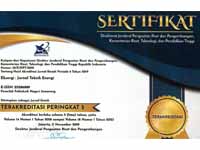Challenges and Solutions in Hydropower: Analyzing Francis Turbine Performance and Operational Dynamics
DOI:
https://doi.org/10.32497/eksergi.v21i02.6592Keywords:
Hydropower, Renewable Energy, Francis Turbine, Turbine Performance, Sediment AccumulationAbstract
This paper addresses the global challenge of sustainable energy, exploring alternatives to dwindling fossil fuels and rising CO2. While renewables like solar and wind offer potential, they face geographical and intermittent limitations. Thermal and nuclear energies are discouraged due to severe environmental and health impacts. Hydropower emerges as a highly reliable and favored global solution, harnessing energy from flowing water, tides, and dams. It's the most prevalent renewable source for electricity, offering consistent, dependable, and emission-free supply. The Francis turbine is crucial to hydropower, known for its high efficiency. Its spiral casing, runner, and guide vanes efficiently convert water's energy into electricity. Water flows from a reservoir to the turbine, where guide vanes regulate entry to the runner, driving a generator. Our analysis reveals key factors affecting hydropower performance: energy source, guide vane opening, servomotor performance, and governor control system. Sediment accumulation at the inlet causes head loss, reducing optimal output. Misaligned guide vane openings can drop rotational speed, leading to suboptimal load. Servomotor issues like wear also require maintenance. A 5% speed drop setting effectively manages water pressure and flow, enabling smooth load escalation.
References
[1] J. Mensah, “Sustainable development: meaning, history, principles, pillars, and implications for human action: literature review,” Cogent Social Sciences. vol. 5, pp. 1653531, issued 1, 2019. https://doi.org/10.1080/23311886.2019.1653531.
[2] D. Kumar, T. Tewary, “Investigating the sustainability of urban energy generation with techno-economic analysis from hybrid energy systems,” Energy Strategy Review, vol. 50. pp. 101-250, 2023, https://doi.org/10.1016 /j.esr.2023.101250.
[3] T. Kashyap, R. Thakur, M. Sethi, R.K. Tripathi, A. Thakur, S. Kumar, P. Kumar, B. Goel, S. Chand, The influence of reflector on the thermal performance of single and double pass solar air heater: a comprehensive review, Mater. Today: Proc. 1 (72) (2023) 1260–1269.
[4] R. Kumar, N. Sharma, Chahat, G.H. Ngo, A.K. Yadav, D. Lee, T. Singh, “Prediction of jet impingement solar thermal air collector thermohydraulic performance using soft computing techniques,” Case Study Thermal Engineering Vol. 55, pp. 104144, 2024. https://doi.org/ 10.1016/j.csite.2024.104144.
[5] T. Singh, “Entropy weighted WASPAS and MACBETH approaches for optimizing the performance of solar water heating system,” Case Study Thermal Engineering, vol. 53, pp: 103922, 2024. https://doi.org/ 10.1016/j.csite.2023.103922.
[6] S. Thapa, R. Kumar, K. Kumar, S. Samir, D. Lee, T. Singh, “Analytical investigation of solar parabolic trough receiver with multiple twisted tapes using exergy and energy analysis,” Case Study Thermal Engineering, vol. 50, pp. 103493, 2023. https://doi.org/10.1016/ j.csite.2023.103493.
[7] R. Kumar, D. Lee, S. Kumar, S. Thapa, A.E. Gürel, A. Thakur, R.D. Jilte, C. A. Saleel, S. Shaik, Ü.Ả. gbulut, “Different energy storage techniques: recent advancements, applications, limitations and efficient utilization of sustainable energy,” Journal Therm. Anal. Calorim. vol. 149, pp. 1895-1933, 2024
[8] Q. Alkhalaf, D. Lee, R. Kumar, S. Thapa, A.R. Singh, M.N. Akhtar, M. Asif,Ü. A˘ gbulut, “Experimental Investigation of the thermal efficiency of a new cavity receiver design for concentrator solar technology,” Case Study Thermal Engineering, vol. 53, pp. 103848, 2024. https://doi.org/10.1016/j.csite.2023.103848.
[9] R. Kumar, M. Sethi, V. Goel, M.K. Ramis, M. AlSubih, S. Islam, M.S.A. Ansari, D. Lee, A.W. Wodajo, “Thermal and effective assessment of solar thermal air collector with roughened absorber surface: an analytical examination,” Int. Journal Low Carbon Technology, vol. 19, pp. 1112-1123, 2024. https://doi.org/10.1093/ijlct/ctae056.
[10] [13] S. Aggarwal, R. Kumar, S. Kumar, T. Singh, Impact of fin material properties and the inclination angle on the thermal efficiency of evacuated tube solar water heater: an experimental study, Journal King Saud University Science. vol. 36, pp. 103186, 2024. https:// doi.org/10.1016/j.jksus.
[11] A.K. Yadav, R. Khargotra, D. Lee, R. Kumar, T. Singh, “Novel applications of various neural network models for prediction of photovoltaic system power under outdoor condition of mountainous region,” Sustainable Energy, Grids and Networks vol. 38, pp. 101318, 2024. https://doi.org/10.1016/j.segan.2024.101318 (ELSEVIER) Cite score 7.1, Impact Factor 5.4, ISSN: 2352-4677.
[12] S. Kumar, R. Kumar, R. Thakur, S. Kumar, D. Lee, “Effects of climate variables and nanofluid-based cooling on the efficiency of a liquid spectrum filter-based concentrated photovoltaic thermal system,” J. Therm. Anal. Calorim. vol. 149, pp. 2273-2291, 2024. https://doi.org/10.1007/s10973-023-12836-4.
[13] 12[16] S. Kumar, R. Thakur, S. Kumar, D. Lee, R. Kumar, Impact of liquid spectrum filter and solar tracker on the overall effectiveness of a photovoltaic thermal system: an experimental investigation, Renew. Energy 226 (2024) 120390, https://doi.org/10.1016/j.renene.2024.120390.
[14] Robin Thakur, Sushil Kumar, Tanish Kashyap, Raj Kumar, Raj Kumar Saini, Daeho Lee, Tej Singh, “Potential of the Archimedes screw to generate sustainable green energy for mini, micro, and pico hydro Turbine power stations: An extensive analysis,” Energy Strategy Reviews, vol. 55, pp. 101514, 2024.
[15] H. Benigni, J. Schneider, W. Reckendorfer, H. Jaberg, G. Zenz, J. Tuhtan, “Numerical simulation and experimental verification of downstream fish migration in a kaplan turbine,” InIOP conf. Series: earth and, Environ. Sci. vol. 774, issued 1, pp. 012149. 2021.
[16] E. Kocak, S. Karaaslan, N. Yucel, F. Arundas, “A numerical case study: bovet approach to design a Francis turbine runner,” Energy Procedia, vol. 111, pp. 885-894. 2017.
Downloads
Published
Issue
Section
License
Copyright (c) 2025 Baktiyar Mei Hermawan, Mochamad Denny Surindra, Suwarti, Slamet Priyoatmojo, F. Gatot Sumarno

This work is licensed under a Creative Commons Attribution 4.0 International License.
Authors who publish with this journal agree to the following terms:Authors retain copyright and grant the journal right of first publication with the work simultaneously licensed under a Creative Commons Attribution License that allows others to share the work with an acknowledgement of the work's authorship and initial publication in this journal.
Authors are able to enter into separate, additional contractual arrangements for the non-exclusive distribution of the journal's published version of the work (e.g., post it to an institutional repository or publish it in a book), with an acknowledgement of its initial publication in this journal.
Authors are permitted and encouraged to post their work online (e.g., in institutional repositories or on their website) prior to and during the submission process, as it can lead to productive exchanges, as well as earlier and greater citation of published work (See The Effect of Open Access).






